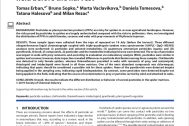Obsah
BACKGROUND: Pesticides or plant protection products (PPPs) are risky for spiders in or near agricultural landscapes. However, the risks posed by pesticides to spiders are largely understudied compared with the risks to pollinators. Here, we investigated the distribution of PPPs in adult females, cocoons and webs with prey remnants of Phylloneta impressa.
RESULTS: Three sample types were collected from the tops of rapeseed on 18 July (before the harvest). Three different ultraperformance liquid chromatograph coupled with triple-quadrupole tandem mass spectrometer (UHPLC–QqQ–MS/MS) analyses were performed: (i) pesticides and selected metabolites
(ii) quaternary ammonium pesticides (quats)
and (iii) pyrethroids. Overall, 23 compounds, 22 pesticides and the metabolite imidacloprid-urea were detected. The array of pesticides was largest in webs with prey remnants, and according to evaluation via redundancy analysis (RDA), pesticides were similar in spiders and cocoons
however, data inspection revealed differences in pesticide distribution among these samples. Clothianidin was detected in only female spiders, whereas thiamethoxam prevailed in webs with remnants of prey, and acetamiprid, thiacloprid and imidacloprid were found in all three matrices. One of the most abundant compounds was chlormequat, indicating that quats should be considered a possible risk for these spiders. None of the pyrethroids were detected despite being applied in the sampling area, indicating rapid biodegradation. By contrast, some pesticides were detected despite not being applied in the field, indicating that the source of contamination is prey or particles carried by wind and attached to webs.
CONCLUSION: Overall, the results indicate the different distribution or behavior of several pesticides in the spider matrices.
© 2019 Society of Chemical Industry



